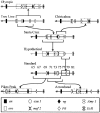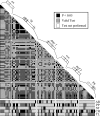Evolutionary genomics of inversions in Drosophila pseudoobscura: evidence for epistasis
- PMID: 12824467
- PMCID: PMC166227
- DOI: 10.1073/pnas.1432900100
Evolutionary genomics of inversions in Drosophila pseudoobscura: evidence for epistasis
Abstract
Drosophila pseudoobscura harbors a rich polymorphism for paracentric inversions on the third chromosome, and the clines in the inversion frequencies across the southwestern United States indicate that strong natural selection operates on them. Isogenic inversion strains were made from isofemale lines collected from four localities, and eight molecular markers were mapped on the third chromosome. Nucleotide diversity was measured for these loci and formed the basis of an evolutionary genomic analysis. The loci were differentiated among inversions. The inversions did not show significant differences among populations, however, likely the result of extensive gene flow among populations. Some loci had significant reductions in nucleotide diversity within inversions compared with interspecies divergence, suggesting that these loci are near inversion breakpoints or are near targets of directional selection. Linkage disequilibrium (LD) levels tended to decrease with distance between loci, indicating that some genetic exchange occurs among gene arrangements despite the presence of inversions. In some cases, however, adjacent genes had low levels of interlocus LD and loosely linked genes had high levels of interlocus LD, suggesting strong epistatic selection. Our results support the hypothesis that the inversions of D. pseudoobscura have emerged as suppressors of recombination to maintain positive epistatic relationships among loci within gene arrangements that developed as the species adapted to a heterogeneous environment.
Figures


References
-
- Powell, J. R. (1992) in Drosophila Inversion Polymorphism, eds. Krimbas, C. B. & Powell, J. R. (CRC, Boca Raton, FL), pp. 73-126.
-
- Dobzhansky, T. (1944) Carnegie Inst. Washington Publ. 554 47-144.
-
- Anderson, W. W. (1989) Genome 31 239-245. - PubMed
Publication types
MeSH terms
LinkOut - more resources
Full Text Sources
Molecular Biology Databases
Research Materials

